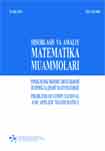Modeling the Dispersion of Pollutants in the Atmosphere, Accounting for Terrain and Meteorological Conditions
DOI:
https://doi.org/10.71310/pcam.4_68.2025.01Keywords:
advection-diffusion, Pasquill-Gifford, Monin-Obukhov length, wet deposition, sedimentation (Stokes), vegetation sinks, terrain, Upwind/QUICK, CFLAbstract
This work proposes an expanded 3D Euler model for calculating the spatiotemporal evolution of pollutant concentrations released into the atmosphere under changing meteorological conditions. The model, alongside the advection-diffusion equation, combines in a single system: Stokes’ law deposition (for solid particles), temperature-dependent chemical decomposition according to Arrhenius’ law, retention by plants (passive sink), precipitation washout (rainout), terrain-dependent resistance, and parameterization of turbulent diffusion based on Pasquill-Gifford stability classes. The numerical solution employs upwind/QUICK convective fluxes, central difference diffusion, and a time step stabilized by the CFL criterion. Scenarios covering various wind directions and speeds demonstrate the role of terrain in flow direction and atmospheric-related dispersion characteristics. The model is mass-balanced.
References
Ravshanov N., Nazarov Sh.E., Boborakhimov B. Modeling the process of spreading pollutants in the atmosphere taking into account the capture of particles by vegetation elements // Lobachevskii Journal of Mathematics. – 2024. – Т. 45, – № 3. – С. 1156–1169.
Arya S.P. Meteorology and dispersion of pollutants in the atmosphere // Oxford: Oxford University Press, – 1999.
Seinfeld J.H., Pandis S.N. Atmospheric Chemistry and Physics: From Air Pollution to Climate Change // New York: Wiley, – 2016.
Zannetti P. Modeling of air pollution: theories, computational methods and available software // Berlin: Springer, – 1990.
Pasquill F., Smith F.B. Atmospheric Diffusion // New York: Wiley, – 1983.
Stall R.B. Introduction to boundary layer meteorology // Dordrecht: Kluwer Academic Publishers, – 1988.
U.S. Environmental Protection Agency (EPA). AERMOD Model: Formulation and Validation // 2021. – Access mode: https://www.epa.gov/scram/air-qualitydispersionmodeling
Hanna S.R., Briggs G.A., Hosker R.P. Handbook of Atmospheric Diffusion // Washington: US Department of Energy, - 1982.
Houlton J.R. Introduction to Dynamic Meteorology // Academic Press Amsterdam: – 2004.
Venkatram A., Wingard J.K. Lectures on Air Pollution Modeling // American Meteorological Society. Boston, 1988.

Downloads
Published
Issue
Section
License
Copyright (c) 2025 N. Ravshanov

This work is licensed under a Creative Commons Attribution 4.0 International License.



